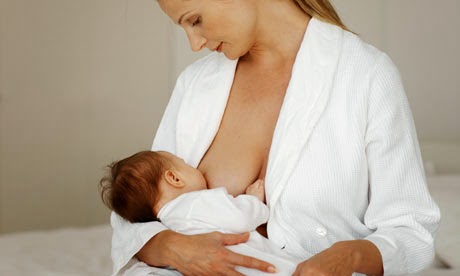 A woman who is
breast-feeding should not eat Cabbage and garlic but must consume beer and
tomatoes! Such are the assertions that will hear a woman who gives the breast!
Because the food during lactation is the subject of many received ideas!
A woman who is
breast-feeding should not eat Cabbage and garlic but must consume beer and
tomatoes! Such are the assertions that will hear a woman who gives the breast!
Because the food during lactation is the subject of many received ideas!
The advice to
the address of the new mother are often a picturesque amalgam of facts, fiction
and customs. The popular beliefs are very different from one country to another
but the food of the woman who is breastfeeding is a matter of concern
quasi-universal. In reality, the calorie requirements of the nursing mother
depends on the amount of milk she produced during the day. A daily increase of
500 calories with 25 g of additional proteins is sufficient to cover the needs
of the breast (2,500 Kcal/j). No need to
"eat for two" as the advised recently still a certain popular belief.
Increased needs
During
lactation, there has been an increased demand for vitamins and mineral salts
(calcium) and it is sufficient to cope to adopt a balanced diet:
·
A
protein contained 60 to 80 g/j (10 to 15% of the energy balance) ;
·
A
fat intake of 80 g/j (30 to 35% of energy needs) ;
·
A
carbohydrate intake of 340 g/l (50 to 55% of energy needs).
A contribution
the nomination paper to the maximum of 750 ml/j. is recommended in the form of
milk or dairy products: cheeses, yogurt, etc. It allows in particular to cover
the needs in calcium which are 1200 mg/j among the women who are
breast-feeding. A quantity of liquid, sufficient (at least 1.5 liters/day) is
recommended.
That said, a
woman who is breastfeeding can eat what she wants! This is not the time for it
to start a diet dieting.
Flavored milk?
Some foods give
a taste to the milk and doctors have decided to arbitrarily ban, probably because
they themselves do not like. To a certain extent, the power supply of the
nursing mother is part of the gastronomic education of the child who will be
led to share them later the family kitchen. The warning against the consumption
of certain foods is particularly tasty when it is studied according to the
times and countries. In the United States, it is the chocolate that is
prohibited because it would give the diarrhea ... ! In New Zealand, the cabbage
and tomato soup are deprecated while in Italy the mother has the right to the
tomato and food white to the color of the milk (pasta, white wine ... ) ... !
In France, it was the habit of preventing expectant mothers that some foods
give a pronounced taste to milk: leeks, celery, cauliflower, asparagus, garlic,
onions etc. .. The move of peremptory manner of the nursing mother falls
under the dictatorship taste! Nothing prevents the babies to appreciate the
milk flavored with garlic or to asparagus and it was sufficient to convince us
of the susceptibility bizarre taste of babies to taste some foods for infants!
We realize then immediately of their amazing abilities to digesting food flavor
very ... special ... !
Breastfeed spicy ...
Geneviã¨ve Delaisi of Parseval and
Suzanne Lallemand font the history of these prohibitions and one learns as well
as the cabbage, onion and garlic are prohibited in 1921 by Pouliot, that the
exclusion of the asparagus appears 1939 under the pen of a
certain Lerebouillet and that the Cresson made its entry in the list of
products censored in 1946 in a book of Ouria-Raffin ... In contrast, some spice
or spices (curry, cumin, fennel etc. ) by giving a good taste to the milk
stimulates the sucking infant and by that same, lactation. They are employed as
lactogenic substances in India and Africa.
So if the mother
can eat what she likes, it must be recalled here that the excessive consumption
of alcohol, wine, coffee, tea or tobacco that "pass" to various
degrees in the milk is harmful. Two packets of cigarettes per day are
dangerously fit the level of nicotine in the milk.
